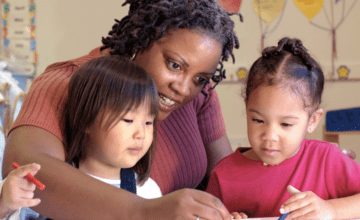Learn how to support early language development from birth to three with these parent-child activities.
IN THIS RESOURCE
Gather Round activities are designed to help families promote their child’s language and literacy skills, while also nurturing the other domains of development. A children’s book is suggested for each topic area and age and activities related to the book based on a range of developmental domains and early skills. The activities can be used with parents as a tool to promote children’s learning through book-sharing and age-appropriate parent-child activities.
Birth to 12 Months
Book:
Good Night, Gorilla by Peggy Rathmann
Publisher: Putnam Juvenile
Activities that build on the ideas in Good Night, Gorilla:
1) Choose one of your child’s stuffed animals and play good night/good morning. Say “good night” to his furry friend and show your baby how his “pet” goes to sleep (and perhaps snores in a funny way!) Then, have his pet wake up and say “good morning” and give your child a big kiss.
2) Use the stuffed animal to sing songs to your child or to tell her stories. Make the “pet” sneeze or have it play peek-a-boo with your baby. Watch and see how your child responds to this kind of play.
3) Babies and toddlers learn through repetition. That is one of the reasons why this story is so appealing for little ones! Before your baby goes to sleep, say “good night” to his stuffed animals, his toothbrush, his night light, his pacifier, and so on. This helps your baby cope with separations, like bedtime, and also teaches him new words as you talk out loud about what you are doing together.
4) In this story, the zookeeper uses a flashlight to see while he puts all the animals to bed. Have some flashlight tummy time with your baby. Place your baby on her tummy in a darkened room (pull the shades or shut the blinds). Lie next to your baby and shine a flashlight on the floor in front of you both or on the wall opposite you. Point out the light to your little one. Make the beam move slowly back and forth. Make the light dance a bit. If your baby isn’t crazy about tummy time, sometimes a new distraction can keep her on her tummy a little longer.
5) Each morning when your baby wakes up, greet her with a big “Hi!” and a wave. Combining words with actions helps young children learn the meaning of those words and teaches them about the power of using gestures to communicate.
12–24 Months
Book:
Jamberry by Bruce Degan
Publisher: HarperFestival
Activities that build on the ideas in Jamberry:
1) Take out a pot and wooden spoon—or any household objects your child can use for drumming—and show your child how she can make sounds with it. See if she would like to play the drum while you read the story.
2) Put your child on your lap and say the alphabet, tapping on the drum for each letter (be sure that you pause between
“L-M-N-O-P,” making a drum tap for each one). The steady beat of a song, combined with singing the song again and again, helps children’s brains (and adults’ brains!) remember the words or lyrics. (Think of how you can sing along to the radio after hearing a popular song played over and over.) So by singing the alphabet song with your child, you are actually helping him begin to learn these 26 very important letters! Encourage your toddler to do the tapping while you say the alphabet again.
Don’t expect him to get the timing right. It’s more important that he participate and enjoy the activity.
3) Create picture books for your toddler using family photos or interesting pictures cut out from magazines or catalogs. Glue pictures to sturdy pieces of cardboard or index cards and staple them together. Let your toddler look at each one while you describe it. Books don’t always need words to be fun for children!
4) Have fun with language! In this book, the author makes up a lot of pretend words. You can too! “Stacey-berry, Stacey-berry, come eat your lunch-berry.” Young toddlers love silly words and songs. Even better, listening to songs and rhymes help children develop new language skills.
5) Jamberry is a very active book. Get moving with your toddler by choosing one of his favorite songs and singing it together. Grab a rattle or jingle bells and sing the song again while making music in your “family band.”
24–36 Months
Book:
Sheep in a Jeep by Nancy Shaw
Publisher: Houghton Mifflin Company
Activities that build on the ideas in Sheep in a Jeep:
1) Ask your child to choose a toy car (or make one from a shoebox—glue on cardboard circle “wheels” but make sure you child can still slide it along the floor). Make the sounds of a car: “brrrrrmmm” and “beep beep!” How does your toddler play with this “Jeep”? Playing pretend is a great way for your child to develop literacy skills as he acts out stories of his own creation.
2) Play *Sheep in a Jeep* at your own house. Create a hill by balancing a book on top of a stack of other books. Let the car roll down as you say, “Sheep in a Jeep on a hill that is steep!” You can make the hill a bit steeper by adding books to the pile. Notice together how, the steeper the hill, the farther the car rolls. Acting out the story helps your child begin to understand what the words and story mean.
3) Take or draw a picture of your child’s toy car. Then ask your child to tell you about how she likes to play with the car. Write her words down under the drawing or photo, exactly as she says them, and hang it at her level where she can see it. You can read her words and visit the picture each day. This tells your child that language is important in your family, and that you are interested in what she has to say.
4) Take a walk around your neighborhood and snap photos of the different vehicles you see. Make a book of these photos, labeling each photo with some information about each vehicle: “This is the garbage truck. It takes away our trash.”
5) Make a toddler-sized “Jeep” for your child to drive at home. Take a large box and cut out a door. Then glue on four paper plate wheels. Ask your child where he would like to go in his car. Creating pretend play stories to act out is a great way to build your toddler’s language skills.




